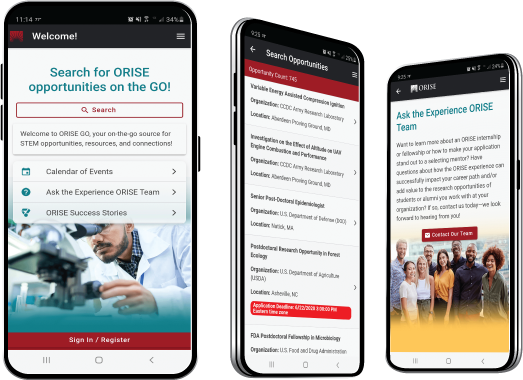Postdoctoral Research Opportunity in Canopy Architecture and Photosynthesis
A complete application package consists of:
- An application
- Transcript(s) – For this opportunity, an unofficial transcript or copy of the student academic records printed by the applicant or by academic advisors from internal institution systems may be submitted. Selected candidate must provide proof of completion of the degree before the appointment can start. Proof must be sent to ORISE directly from the academic institution including graduation date and degree awarded. All transcripts must be in English or include an official English translation. Click Here for detailed information about acceptable transcripts.
- A current resume/CV
- Two references – While two references are requested, applications will be considered without reference information. It is preferred that a complete application package contains a minimum of one reference.
If you have questions, send an email to USDA-ARS@orau.org. Please include the reference code for this opportunity in your email.
A postdoctoral research opportunity in canopy architecture and photosynthesis is available with the the U.S. Department of Agriculture (USDA), Agricultural Research Service (ARS), Global Change and Photosynthesis Research Unit (GCPRU) in Urbana, Illinois.
The project aims to identify and understand genetic variation in soybean and cow pea in canopy architecture and photosynthetic traits. Differences in canopy architecture can influence the light environment within a crop canopy and the subsequent rate and efficiency of photosynthesis of leaves. This project will take advantage of diverse collections of soybean and cowpea to characterize differences in canopy architecture in the two crops, and understand the impacts of canopy architecture on leaf and canopy photosynthesis.
The candidate will design and perform field experiments to investigate natural variation in canopy architecture traits and canopy photosynthesis, and the relationship to photosynthesis. Potential canopy architecture traits that will be investigated in detail include branching, leaf area index, leaf angle, petiole length, light environment within the canopy, leaf reflectance and transmittance. The candidate will learn how canopy architecture traits impact the light environment and photosynthetic potential of soybean and cowpea canopies. This research will support transgenic approaches to manipulate photosynthesis, and will help inform strategies to modify crop canopies for optimum photosynthesis. The candidate would be expected to be familiar with or to learn univariate and multivariate statistical analysis to analyze relationships among canopy architecture traits as well as genome-wide association study analysis and molecular mapping tools to link genotype to phenotype.
The candidate will collaborate with other post-docs and professors on the Realizing Improvements in Photosynthetic Efficiency (RIPE) project, which broadly aims to model and manipulate photosynthesis to increase crop yields. The candidate will participate and present research in RIPE meetings as well as ARS unit meetings. The candidate will also have opportunities to participate in outreach through interactions with the University of Illinois, Institute for Genomic Biology. For example, Genome Day is an outreach opportunity at the local Children's science museum, and the candidate could participate in that event.
The project aims to identify and understand genetic variation in soybean and cow pea in canopy architecture and photosynthetic traits. Differences in canopy architecture can influence the light environment within a crop canopy and the subsequent rate and efficiency of photosynthesis of leaves. This project will take advantage of diverse collections of soybean and cowpea to characterize differences in canopy architecture in the two crops, and understand the impacts of canopy architecture on leaf and canopy photosynthesis.
The appointment is full-time for 12 months, with an anticipated start date of mid-late May, and may be renewed based upon recommendation of the ARS and availability of funding. The selected applicant will receive a monthly stipend as support for their living and other expenses during this appointment. The participant must show proof of health and medical insurance. Health insurance can be obtained through ORISE.
The participant will not enter into an employee/employer relationship with ORISE, ORAU, USDA, ARS, or any other office or agency. Instead, the participant will be affiliated with ORISE for the administration of the appointment through the ORISE appointment letter and Terms of Appointment.
While participants will not enter into an employment relationship with ARS, this position requires a pre-appointment check and a full background investigation.
This opportunity is available to U.S. citizens, Lawful Permanent Residents (LPR), and foreign nationals. Non-U.S. citizen applicants should refer to the Guidelines for Non-U.S. Citizens Details page of the program website for information about the valid immigration statuses that are acceptable for program participation.
For more information about the ARS Research Participation Program, please visit the Program Website.
To be eligible, applicants must have received a a PhD in Plant Biology or Crop Sciences or a related field.
Prior experience measuring leaf canopy architecture, leaf and canopy photosynthetic parameters are preferred. Interest in high throughput phenotyping using visual or infrared imaging, experience with team science, and strong oral and written communication skills are also preferred.

 ORISE GO
ORISE GO

The ORISE GO mobile app helps you stay engaged, connected and informed during your ORISE experience – from application, to offer, through your appointment and even as an ORISE alum!





